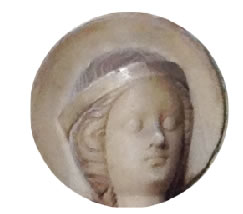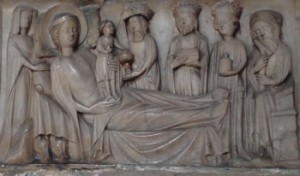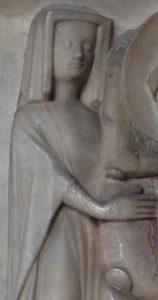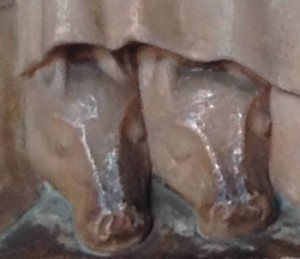Mary and the Reformation
While in the UK I have tried to visit as many churches as I can. Most of the beautiful old churches are now Anglican, having been through the English Reformation which was a traumatic and destructive time.
The lovely Adoration of the Magi illustrating this page is witness to this. It resides in the Anglican parish church of the Holy Trinity in Long Melford, a small village in Suffolk. Back in the fifteenth century, Suffolk was wealthy from the sale of wool, and the “wool barons” used their wealth, in part, to build spectacular local churches. Long Melford was built by the generosity of the Clopton family between 1467 and 1497. The alabaster of the Magi is older than the church, probably mid-fourteenth century. It must have been bought to decorate the church, and may even have been part of the high altar.
The Church of England separated from the Catholic Church in 1534. In the time of Oliver Cromwell it went through a puritan phase that had a terrible impact on the churches. In 1643 parliament passed an ordinance that “all Monuments of Superstition and Idolatry should be removed and abolished” specifying: “fixed altars, altar rails, chancel steps, crucifixes, crosses, images of the Virgin Mary and pictures of saints or superstitious inscriptions.” The next year that list was extended to include representations of angels, rood lofts, holy water stoups, and images in stone, wood and glass on plate.
Despite being the depiction of a scriptural story, the Adoration of the Magi was included among superstitious images as this extract from the journal of William Dowsing “Commissioner for the destruction of monuments of idolatry and superstition” shows:
“Benacre, April 6. There was 6 superstitious pictures, one crucifix, and the Virgin Mary twice, with Christ in her arms, and Christ lying in the manger, and the 3 Kings coming to Christ with their presents, and a Katherine nice [twice] pictured; and the priest of the parish [—] materna Johannem Christi guberna, O Christ govern me by thy mother’s Prayers!—And three Bishops with their mitres; and the steps to be levelled within 6 weeks. And 18 Jesus’s, written in capital letters, on the roof, which we gave order to do out; and the story of Nebuchadnezzar; and Orate pro animabus, in a glass window. [Extracted from Trevor Cooper (ed.), The Journal of William Dowsing: Iconoclasm in East Anglia during the English Civil War, Woodbridge, 2001.]
Benacre is a town near the coast in the same county as Long Melford. It does not appear that Dowsing came to Long Melford, but the work of removing the idolatrous images was done there, perhaps not without resistance. The evidence is that this image of Mary and the Magi was discovered in the eighteenth century buried in the chancel of the church. Perhaps someone hid the valuable piece, hoping to replace it when the tide of destruction had passed.
The piece is finely carved in alabaster and still bears traces of the paint; it would have been brightly coloured when it was a focus of medieval devotion. It is unusual for an Adoration of the Magi: the Virgin Mary is reclining and is disproportionately large. We have a servant at the left plumping the pillow, identified as the midwife, Salome (a character from Christian legend).
Two bovine noses are peering out from under the bed sheet to indicate that the setting is a stable.
Jesus, propped up by his mother, is standing to receive the gifts.
The first and oldest king doffs his crown as he presents his gift in a ciborium. The other two kings, one bearded and middle-aged, one clean-shaven and young, wait patiently, while a very old looking Joseph sits in a chair and nods off leaning on his staff.
Only the Virgin Mary has a halo. She looks young and beautiful.
 The work is now displayed in a place of honour near the sanctuary of the church. The excesses of the Reformation are a long way in the past and are much regretted by those who care for these beautiful churches.
The work is now displayed in a place of honour near the sanctuary of the church. The excesses of the Reformation are a long way in the past and are much regretted by those who care for these beautiful churches.




 Entries(RSS)
Entries(RSS)